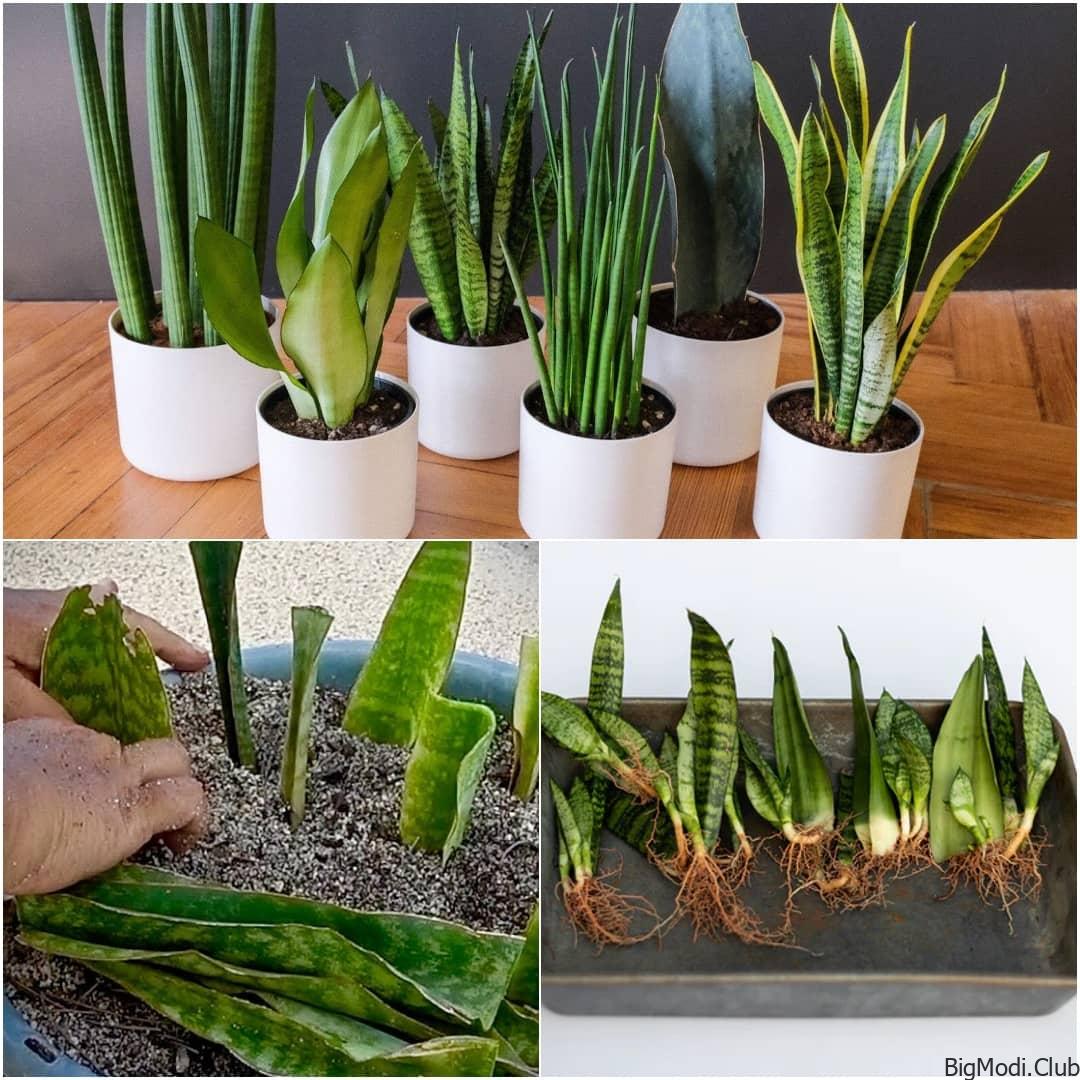The snake plants (Sansevieria), also known as mother-in-law’s tongue, is a hardy and easy-to-care-for houseplant that adds style to any indoor space. Known for its sleek, sword-like leaves and air-purifying qualities, this plant is perfect for beginner and experienced gardeners alike. If you’re wondering how to grow a snake plant successfully, read on for a detailed guide on cultivation, care, and propagation.
What is a Snake Plant?
The snake plant (scientifically known as Dracaena trifasciata) belongs to the Asparagaceae family. It is an evergreen perennial that is typically grown as a houseplant due to its ease of care. Native to West Africa, this plant thrives in various conditions, from bright indirect sunlight to low light, making it a versatile addition to any home.
Characteristics of the Snake Plant
- Common NamesThe snake plant is commonly known as mother-in-law’s tongue due to its sharp, upright leaves that resemble a sword. Other names include Saint George’s sword and viper’s bowstring hemp, reflecting its unique appearance.
- Botanical NameThe snake plant’s botanical name is Dracaena trifasciata. It belongs to the Asparagaceae family, making it a close relative of other popular houseplants.
- Family and Plant TypeAs an evergreen perennial, the snake plant is typically grown as a houseplant. It is known for its ability to thrive indoors, making it a favorite among plant enthusiasts.
How to Grow Snake Plants
Light Requirements for Snake Plants
Snake plants thrive in various lighting conditions but prefer 8 to 10 hours of indirect sunlight or a few hours of early morning direct sunlight. They can tolerate some shade, but prolonged low light conditions may result in slower growth and dull leaf color. To encourage healthy growth, place your plant near a window where it can enjoy bright but filtered light.
Soil Type and Composition
The best soil for a snake plant is a sandy, well-draining potting mix. A cactus potting soil is ideal, as it allows excess water to flow freely, preventing root rot. Avoid soil that holds moisture for too long, such as peat-heavy mixes, as this can lead to overwatering issues.
Watering Instructions
Snake plants are drought-resistant, so they should only be watered when the soil is completely dry. Overwatering is the most common mistake people make with this plant. In winter, reduce the watering frequency, as the plant’s growth slows down. Generally, watering once a month during the colder months is enough.
Signs of overwatering include:
- Yellowing leaves
- Soft, mushy roots
- Leaf drooping or browning
Temperature and Humidity Needs
Snake plants thrive in warm conditions and grow best when the temperature is between 70°F and 90°F. They are not frost-tolerant and should be kept away from cold drafts or temperatures below 50°F. As for humidity, these plants are perfectly happy in average household levels of 30-50% humidity.
Fertilizer Use
Feeding your snake plant with a balanced 10-10-10 fertilizer twice a year—once in the spring and again in mid-summer—will support growth. Dilute the fertilizer to half strength and avoid fertilizing in winter when the plant is dormant.
How to Propagate a Snake Plant
Propagation of snake plants is simple and can be done through division or leaf cuttings. The best time to propagate is in spring or summer, when the plant is actively growing.
Propagation by Division
Division involves separating new shoots or pups from the parent plant. This method is ideal for larger, more mature snake plants.
- Step 1: Gently remove the plant from its pot and place it on a flat surface.
- Step 2: Brush off the excess soil to expose the roots and rhizomes.
- Step 3: Use a sharp knife to cut the plant into sections, ensuring each section has some roots intact.
- Step 4: Repot the sections into separate pots with fresh soil. Water lightly and place them in indirect sunlight.
Propagation by Leaf Cuttings
You can also propagate snake plants from leaf cuttings. Follow these steps:
- Cut a Leaf: Use a sterile knife or scissors to cut a healthy leaf at its base.
- Submerge Partially in Water: Place the cut end of the leaf in a container of clean water and set it in a partly sunny spot. Alternatively, let the cut end callous over for 24 hours before planting it cut-end down in soil.
- Replace with Fresh Water Regularly: If propagating in water, change the water every week or two. If in soil, keep the soil moist.
- Wait for Roots to Form: In one to four months, roots should develop. Once they reach about an inch long, transfer the cutting to cactus potting mix.
- Water and Place in Bright Light: Water thoroughly and position the new plant in bright, indirect light until it’s established.
Snake Plant Care
Pruning Your Snake Plant
Pruning is not usually necessary, but trimming damaged or yellow leaves can encourage new growth. Remove leaves at the base using sharp, clean scissors. Avoid pruning in winter, as the plant is dormant.
Potting and Repotting
Snake plants do well in pots that provide excellent drainage, such as terracotta pots. They should be repotted every 3 to 5 years or when the roots have completely outgrown their container. When repotting, select a pot that is wide and shallow, as snake plant roots grow horizontally.
Common Pests and Problems
Snake plants are generally resilient, but they are prone to some common pests, such as:
- Spider mites
- Mealybugs
- Fungus gnats These can be managed using neem oil or insecticidal soap.
Overwatering can lead to root rot, which manifests as yellowing leaves or mushy roots. To prevent this, ensure that the soil dries out between waterings and always use well-draining soil.
Benefits of Snake Plants
Snake plants are not just attractive but are also incredibly beneficial to have in your home. Some benefits include:
- Air purification: Snake plants are known for their ability to filter toxins like formaldehyde, benzene, and xylene from the air.
- Low maintenance: They require minimal care and can survive periods of neglect.
- Versatility: Snake plants can grow in various light conditions, from bright indirect light to low light, making them ideal for any room in the house.
Common Mistakes to Avoid
Overwatering
The most frequent mistake with snake plants is overwatering. Only water when the soil is dry to the touch, and avoid letting the plant sit in water.
Insufficient Light
While snake plants can tolerate low light, they will not thrive in complete darkness. Ensure they receive indirect light for a few hours a day to maintain healthy growth.
Best Practices for Indoor Snake Plant Care
- Light: Provide 8 to 10 hours of indirect light or a few hours of morning sunlight.
- Soil: Use well-draining, sandy potting mix.
- Watering: Water when the soil is dry and avoid overwatering.
- Temperature: Keep temperatures between 70°F and 90°F and protect from cold drafts.
- Fertilizer: Feed with a balanced fertilizer during the growing season.
FAQs:
1. What is the best way to grow a snake plant?
The best way to grow a snake plant is by placing it in indirect sunlight for 8 to 10 hours a day, using well-draining, sandy potting soil, and watering only when the soil is completely dry. Keep the plant in temperatures between 70°F and 90°F, and fertilize it once in the spring and once in mid-summer with a balanced 10-10-10 fertilizer.
2. Can you grow a snake plant from a cutting?
Yes, you can grow a snake plant from a cutting. Simply cut a healthy leaf from the plant, let the cut end dry out for 24 hours, then place it in water or well-draining soil. If using water, change it regularly until roots form, then transfer the cutting to soil.
3. How do I make my snake plant happy?
To keep your snake plant happy, provide it with indirect sunlight, well-draining soil, and water only when the soil is completely dry. Avoid overwatering, as this can lead to root rot. Keep the plant in warm temperatures (70°F to 90°F) and fertilize during the growing season.
4. How often do you water snake plants?
Water snake plants when the soil is completely dry. In warmer months, this might be every 2-4 weeks, while in winter, you can reduce watering to once a month or less. Overwatering can cause root rot, so it’s important to let the soil dry out fully between waterings.


